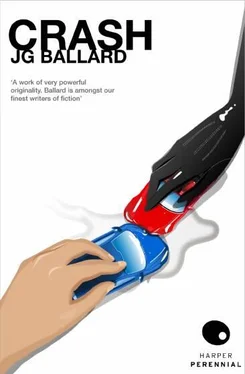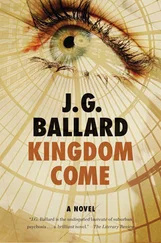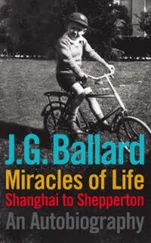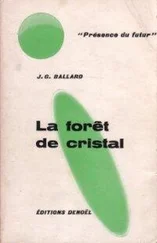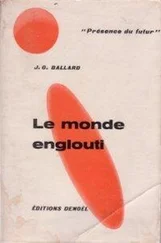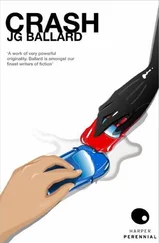The driver of the sports car lay dead in his cockpit, as two firemen and a police constable worked to free him from the buckled overhang of the instrument panel. The woman’s leopard-skin coat which he was wearing had been torn back to expose his crushed chest, but his white platinum hair was still neatly held together by a nylon hair-net. On the seat beside him, like a dead cat, lay a black wig. Seagrave’s slim and exhausted face was covered with shattered safety glass, as if his body were already crystallizing, at last escaping out of this uneasy set of dimensions into a more beautiful universe.
Only five or six feet away from him, the woman driver of the silver Mercedes coup6 lay sideways across her seat below the broken windshield. The crowd of spectators pressed around and over the two cars, almost toppling the ambulance men trying to lift the woman from her crushed driving compartment. From a policeman pushing past with a blanket I heard her name, that of a former television presenter, several years past her bloom but still an occasional performer on panel games and late-night talk shows. As she was propped into a half-sitting position I recognized her face, pallid and drained now like an—old woman’s. A lace-work of dried blood hung from her chin, forming a dark bib. As she was placed on a stretcher, the spectators stared respectfully at the injuries to her thighs and lower abdomen, making way for her when she was carried to the ambulance.
Two women in headscarves and tweed coats were pushed aside. Arms outstretched, Vaughan plunged between them. His eyes seemed to be out of focus. He seized one of the handles already held by an attendant, and swept along with it to the ambulance. The woman was lifted into the back of the vehicle, breathing jerkily through the crust of blood over her nose. I nearly shouted to the police, convinced from the agitated way in which Vaughan bent over the recumbent woman that he was about to draw his penis and use it to free her blood-filled mouth passage. Assuming from his overwrought state that Vaughan was some kind of relative, the attendants stood back for him, but a policeman who recognized Vaughan punched him in the chest with the palm of his hand and shouted to him to move along.
Vaughan hovered around the closing doors, ignoring the constable, then made off through the crowd in a sudden swerve, his bearings lost for the moment. He forced his way to the crushed fibreglass sports car and looked down uncertainly at Seagrave’s body, dressed in its coronation armour of fractured glass, a suit of lights like a dead matador’s. His hands gripped the windshield pillar.
Confused and shaken by the stunt-man’s death and the tags of the film actress’s clothing—themselves the props of a calculated collision—still lying around the car, I followed Vaughan through the spectators. He wandered blankly around the silver Mercedes, eyes fixed on the bloodstains smeared across the seat and instrument panel, examining every piece of the strange litter that had materialized from nowhere after the crash. His hands made small movements through the air, marking out the trajectories of the internal impacts within the car as Sea-grave struck it, the mechanical moments of the second collision between this minor television personality and her instrument panel.
Later, I realized what had most upset Vaughan. This was not Seagrave’s death, but that in his collision, still wearing Elizabeth Taylor’s wig and costume, Seagrave had pre-empted that real death which Vaughan had reserved for himself. In his mind, from that accident onwards, the film actress had already died. All that remained now for Vaughan was to constitute the formalities of time and place, the entrances of her flesh to a wedding with himself already celebrated across the bloody altar of Seagrave’s car.
We walked back to the Lincoln. Vaughan opened the passenger door, staring at me as if he had never seen me clearly before.
‘Ashford hospital.’ He motioned me on. They’ll take Seagrave there when they’ve cut him loose.’
‘Vaughan… ‘ I tried to think of some means of calming him. I wanted to touch his thigh, press the knuckles of my left hand against his mouth. ‘You’ve got to tell Vera.’
‘Who?’ Vaughan’s eyes cleared momentarily. ‘Vera—she knows already.’
He drew from his pocket a grimy square of silk scarf. He spread it carefully on the seat between us. Lying in the centre was a triangle of bloodstained grey leather, the drying blood still a bright carmine. Experimentally, Vaughan touched the blood with his fingertips, brought it up to his mouth and tasted the tacky fragments. He had cut the piece from the front seat of the Mercedes, where the blood from the woman’s abdominal wounds had flowed between her legs.
Mesmerized, Vaughan stared at the fragment, prodding the stitched vinyl inlay that traversed the triangle from its apex. It lay between us like a saintly relic, the fragment of a hand or shinbone. For Vaughan this piece of leather, as delicious and as poignant as the stains on the gusset of a shroud, contained all the special magic and healing powers of a modern martyr of the super-highways. These precious square inches had pressed against the vulva of the dying woman, stained with the blood that had flowed from her wounded genital orifice.
I waited for Vaughan at the entrance to the hospital. He ran towards the casualty department, ignoring the shout of a passing attendant. I sat in the car outside the gates, wondering if Vaughan had been waiting here with his camera when my own injured body was brought in. At this moment the injured woman was probably dying, her blood pressure falling, organs heavy with uncirculated fluid, a thousand stagnant arterial deltas forming an ocean bar that blocked the rivers of her bloodstream. I visualized her lying on a metal bed in the emergency ward, her bloodied face and shattered nasal bridge like the mask worn at an obscene halloween, the initiation rite into one’s own death. I visualized the graphs that recorded the falling temperatures of her rectum and vagina, the steepening gradients of nerve function, the last curtains of her dying brain.
Along the pavement a traffic policeman walked towards the car, clearly recognizing the Lincoln. When he saw me behind the wheel he moved on, but for a moment I had relished being identified with Vaughan and the uncertain images of crime and violence that were forming in the eyes of the police. I thought of the crashed cars at the collision site, of Seagrave dying during a last acid trip. In the moment of her collision with this deranged stunt-driver the television actress celebrated her last performance, marrying her body with the stylized contours of the instrument panel and windshield, her elegant posture with the violent conjunctions of colliding door panels and bulkheads. I visualized the accident filmed in slow motion, like the simulated collisions we had seen at the Road Research Laboratory. I saw the actress colliding with her instrument panel, the steering column buckling under the weight of her heavy-breasted thorax; her slim hands, familiar from a hundred panel games, feinting with the razor-sharp louvres of the ashtray and instrument clusters; her self-immersed face, idealized in a hundred close-ups, three-quarter profile lit by the most flattering light densities, striking the upper rim of the steering wheel; her nasal bridge crushed, upper incisors driven back through her gums into her soft palate. Her mutilation and death became a coronation of her image at the hands of a colliding technology, a celebration of her individual limbs and facial planes, gestures and skin tones. Each of the spectators at the accident site would carry away an image of the violent transformation of this woman, of the complex of wounds that fused together her own sexuality and the hard technology of the automobile. Each of them would join his own imagination, the tender membranes of his mucous surfaces, his groves of erectile tissue, to the wounds of this minor actress through the medium of his own motorcar, touching them as he drove in a medley of stylized postures. Each would place his lips on those bleeding apertures, lay his own nasal septum against the lesions of her left hand, press his eyelids against the exposed tendon of her forefinger, the dorsal surface of his erect penis against the ruptured lateral walls of her vagina. The automobile crash had made possible the final and longed-for union of the actress and the members of her audience.
Читать дальше
Конец ознакомительного отрывка
Купить книгу
